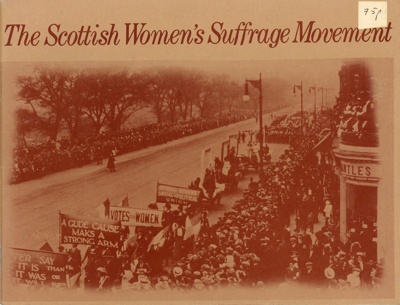Name/TitleThe Scottish Women's Suffrage Movement
About this objectPaperback pamphlet titled 'The Scottish Women's Suffrage Movement' compiled by Elspeth King "to accompany the Government sponsored "Right to Vote" exhibition organised to commemorate the 50th Anniversary of the Representation of the People Act, from 9th September-7th October 1978." The cover image is captioned 'National Suffrage Demonstration, Princes Street, Edinburgh, 9th October 1909.' The main sections of the pamphlet are headed as follows:
- Introduction
- Historical Background
- Origins and early history of the women's suffrage movement in Scotland
- Changing Attitudes
- The Women's Social and Political Union
- The Women's Freedom League
- The Scottish Federation, NUWSS
- Male Support
- "Scottish Outrages"
- The War Effort
- Suffrage Memorabilia in the People's Palace Museum
Fully digitised (33 pages)
MakerKing, Elspeth
Maker RoleAuthor
MakerGlasgow Museums, E. Marshall
Maker RoleDesigner
Date Made1978
Period1900s-1920s
Place MadeScotland, Glasgow
Medium and MaterialsOrganic, paper
MeasurementsH: 191 x W: 251 mm
Subject and Association Keywordswomen's suffrage, right to vote
Subject and Association Keywordssuffragettes, militant suffrage campaign
Subject and Association Keywordswomen's war work
Subject and Association Keywordsgender (in)equality
Subject and Association Descriptionhttps://en.wikipedia.org/wiki/Elspeth_King:
Dr Elspeth King is a Scottish curator, writer and social historian. She is known for her role as curator of social history at the People's Palace Museum in Glasgow, as Director the Stirling Smith Art Gallery and Museum, and for her scholarship on the Scottish Suffrage movement.
https://en.wikipedia.org/wiki/Representation_of_the_People_Act_1918:
The Representation of the People Act 1918 was an Act of Parliament passed to reform the electoral system in Great Britain and Ireland. It is sometimes known as the Fourth Reform Act. The Act extended the franchise in parliamentary elections, also known as the right to vote, to men aged over 21, whether or not they owned property, and to women aged over 30 who resided in the constituency whilst occupying land or premises with a rateable value above £5, or whose husbands did. At the same time, it extended the local government franchise to include women aged over 30 on the same terms as men. It came into effect at the 1918 general election.
As a result of the Act, the male electorate was extended by 5.2 million to 12.9 million. The female electorate was 8.5 million. The Act also created new electoral arrangements, including making residence in a specific constituency the basis of the right to vote, institutionalising the first-past-the-post method of election, and rejecting proportional representation, although this failed by only seven votes in the Commons during the Act's progress. It was not until the Representation of the People (Equal Franchise) Act 1928 that women gained electoral equality. The 1928 Act gave the vote to all women aged over 21, regardless of any property qualification, which added another five million women to the electorate.
Named CollectionGlasgow Women's Library
Object TypeBooklet
Object numberGWL-2015-42-1
Copyright LicenceAll rights reserved
